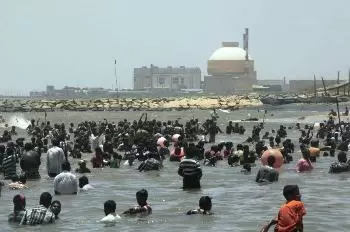PMANE turns to Mamata to take up their cause

06-October-2012
Vol 3 | Issue 40
Having exhausted almost all other avenues barring the Supreme Court, the People’s Movement Against Nuclear Energy agitating for more than a quarter century against the Koodankulam Nuclear Power Project (KKNPP) has turned to the West Bengal Chief Minister, Mamata Banerjee, who fought valiantly against the Haripur nuclear project at Purba in Medhinipur district even before assuming office, to lend a helping hand to stop commissioning the plant.
Mamata had recently said, “I will go everywhere in the country to protect local business, farmers, labourers and the people of India. Everything has a Lakshman rekha, and when it is crossed, I must work for the aam aadmi.”
 |
|
The government has launched a wave of repression against PMANE and slapped sedition cases against 8,000 peaceful protesters (Photo: Antony Kebistan Fernando)
|
Welcoming her statement, SP Udayakumar, M Pushparayan, MP Jesuraj and Fr. F Jayakumar of PMANE, in a letter to Mamata on 5 October, said: “To save the ordinary citizen of our country and to safeguard their survival, wellbeing and freedom, the country needs the intervention of thoughtful, caring and creative leaders like you.
“May we request you to visit us at Idinthakarai, support our struggle, and help our country envision a people-friendly, nature-friendly and future-friendly energy policy, and design alternative energy programmes and projects that protect our people’s right to life and livelihood, and safeguard the interests of our youth and children?”
Earlier, former Supreme Court judge VR Krishna Iyer wrote to Tamil Nadu Chief Minister Jayalalitha saying: “On my bended knees, for the safety of the people of Tamil Nadu, please halt the Koodankulam plant. You have given a great lead, but alas, the KKNPP will undo the progress.”
Recalling how he prevented the project from coming up in Kerala, he said: “I opposed it in Moscow and told the scientists that along with giving us a nuclear plant, you could also give us a mass mortuary.” His appeal to Jayalalitha fell on deaf ears.
An undeclared emergency-like situation prevails in the fishing hamlet of Idinthakarai, nerve centre of the agitation, which comes within the sterile zone of the Koodankulam project.
The news of loading enriched uranium fuel into the nuclear reactor without fulfilling the mandatory safety requirements has spread a pall of gloom among the people of the area who have come to look upon Mamata as their last hope to stop the project.
The Civil Liability for Nuclear Damage Act, 2010, limits the liability to Rs. 1,500 crore. EAS Sarma, former Union power secretary, and G Sundarrajan, a social activist from Tamil Nadu, have said in their PIL, the cap on liability will have a severe impact on the safety of nuclear installations.
Though the Act imposes a very minimal liability on the nuclear reactor supplier, the government of India has made the Russian supplier of the Koodankulam reactor exempt from even this minimal liability. This indemnification has dangerous implications.
For instance, the Nuclear Power Corporation of India’s (NPCIL) contract with the Russian supplier stipulates the reactor pressure vessel should not have any welds. The one supplied and installed at Koodankulam was found to have three welds in its core section.
The Koodankulam plant was built without proper environmental clearance under the Environment Protection Act, 1994. Enormous changes had been made in the plant from what was originally envisaged and the clearance obtained in 1989 with meaningless conditions.
The law as it stands today states that an environment clearance is valid for five years from the start of operation or construction. Construction in Koodankulam started only in 2002 by which time the 1989 clearance had elapsed.
NPCIL never applied as per the EIA notification under the Environmental Protection Act which mandates a public hearing based on which environmental clearance is given.
Under the original 1988 agreement between India and the erstwhile USSR, radioactive waste (spent fuel) would be transported back to USSR. This was completely reversed when India and Russia signed a fresh agreement in 1998 under which radioactive waste would be retained and stored at the Koodankulam plant site for at least seven years.
However, no proper arrangements have been made and no solution to its storage has been found. The storage of nuclear waste is a serious problem across the world to which no sustainable solution has been found so far.
The problem of nuclear waste is especially acute in a densely populated country like India. Burying the radioactive waste in the ground can poison the soil and groundwater. Therefore a thorough review of the safety of the reactor and storage of spent fuel by independent experts is called for.
After the Fukushima disaster, the government of India appointed a Task Force to review the safety of nuclear power plants in the country. It recommended 17 safety measures for the Koodankulam plant.
The Atomic Energy Regulatory Board accepted these recommendations and agreed to implement them by November this year and gave an assurance in the Madras High Court by an affidavit that it would give clearance to load fuel only after implementing these safety measures.
On 10 August, AERB gave fuel loading clearance even before implementing 11 of the 17 safety measures. AERB filed an affidavit stating the NPCIL has given them a fresh schedule that implementation of the 11 critical safety measures would take six months to two years.
Still the NPCIL wants to commission the plant immediately. Why this hurry? Unfortunately, the AERB works under the Department of Atomic Energy, which means the regulator is subordinate to whom it is supposed to regulate.
The present chairman of AERB was formerly chairman of NPCIL and was involved in the construction of the Koodankulam plant. The lack of independence of AERB has been severely criticised by the Comptroller and Auditor-General of India.
The Convention of Nuclear Safety mandates independence of the nuclear safety regulator. India is a party to the convention. It is clear that NPCIL and AERB are taking grave risks with the safety of the Koodankulam plant and in their hurry to commission it under pressure from the Prime Minister’s Office are playing with the health and life of millions of people.
 |
|
Mamata Banerjee
|
The government, in its hurry to commission the plant in utter disregard of safety requirements, has not even complied with the statutory guidelines framed by the National Disaster Management Authority, of which the Prime Minister is the chairman, regarding nuclear safety.
Under its guidelines, the Tamil Nadu government should set up State level and district level disaster management authorities to deal with nuclear accidents, train officials, set up infrastructure and designate hospitals to treat nuclear accident victims. None of it is in place.
As per safety standards, every nuclear plant must have an ‘exclusion zone’ of 1.6 km radius. A 450-tenement tsunami rehabilitation colony of more than 4,000 people stands less than one kilometer from the Koodankulam plant.
Parts of it are 800 metres away from the reactor domes. Apart from the exclusion zone, there must be a sterilised zone of 10 km where not more than 3,000 people can reside.
More than 40,000 people live within a five km radius of the plant, 20,000 at Koodankulam village itself and another 20,000 at neighbouring Idinthakarai village. All this has been ignored by the government and AERB.
It is therefore clear that KKNPP suffers from several infirmities that need to be corrected before the plant can be commissioned.
Instead of addressing these problems, the government has launched a wave of repression against PMANE and slapped sedition cases against 8,000 peaceful protesters, including a few teenagers. Can Mamata fix it?
Sam Rajappa is Consulting Editor of The Weekend Leader














